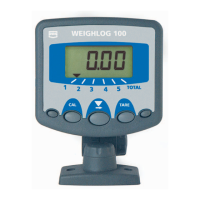2 - Maintaining Accuracy
Page 5
The Weighlog translates pressure (or strain) to weight by means of a calibration factor
programmed into the instrument. The accuracy of the system depends to some extent
on the following:
2.1Machine Requirements
1. Operation Temperature: Always allow the machine and the hydraulics to warm
up to the normal operating temperature before weighing.
2. Weighing on level ground: Avoid weighing when on a slope or a side slope.
When ever possible weigh on a level surface.
3. Vehicle Movement: Best results will be obtained weighing while the
machine is stationary. It is important that the load does not bounce or jerk
as it is lifted.
4. Maintenance: Keep the machine maintained in good working condition. Things
like excessively worn bushings, piviot pins and hydraulic leaks, as well as the
lack of lubrication to grease points can have adverse effects on weighing accuracy.
NOTE: After any major service especially if you have replaced worn components or hydraulic
repairs, you should re-calibrate the system. If the hydraulic system has been drained
and re-filled you should also check for any air which may be trapped at the pressure
sensor.
2.2Lifting Procedure
The correct lifting procedure is especially important for dynamic weighing. The
load should be lifted smoothly and consistantly through the weighing position.
The engine speed should be the same for each lift when weighing.
The best procedure is as follows:
1. After picking up load or loading the bucket roll bucket back against the stops.
2. Throttle the engine to the proper RPM for weighing (the speed used to calibrate).
3. Pull the lift lever completely back and raise load smoothly without bouncing or
jerking. Continue to raise load through the weighing position (dynamic weighing)
or stop lift at the reference position (static weighing).

